Part of the answer depends upon how you count it.
Also, before one gets lost in the "trees" of the many U.S. court systems, it is important to note that the bulk of litigation of significance happens in ordinary state courts. These courts handle the lion's share of misdemeanor and felony criminal prosecutions (especially for "blue collar crimes") and the vast majority of ordinary civil litigation. With all but a handful of exceptions, state courts have concurrent jurisdiction with federal courts over civil lawsuits arising out of federal law. Some areas of law like domestic relations and probate are in the exclusive jurisdiction of state courts and territorial courts (including the local courts of the District of Columbia).
Administrative law tribunals and tribunals that make personnel decisions particularly complicate the matter (33 U.S. federal agencies have administrative law judges and a list of federal tribunals in the U.S. can be found here). As noted by Ballotpedia:
The federal government employed nearly 2,000 administrative law judges
and more than 10,000 administrative judges and other non-ALJ
adjudicators as of 2017. Unlike administrative law judges, who are
officers of the United States and must be appointed by the president,
the courts, or agency heads, administrative judges are hired directly
by agencies. As such, administrative judges do not share in the
statutory protections from removal, discipline, and performance
reviews that ALJs receive under the Administrative Procedure Act.
According to Paul Verkuil, former chairman of the Administrative
Conference of the United States, administrative judges generally have
less independence than administrative law judges, are compensated at a
lower rate, and have less job security.
Another tricky question is where one system ends and another begins. Is it a question of which legislative body authorizes it, of whether it is bureaucratically managed as a unit, the existence of a chain of direct appeals to other courts in the system, of whether it has a shared set of substantive and procedural rules, etc.?
And, then there is the question of what constitutes a judicial system (e.g. does it decide individual cases unlike policy-making boards, does it resolve disputes non-consensually unlike mediation forums, does it matter that it has non-judicial functions as well such as policy-making or being a center for filing undisputed documents, does it have to be permanent or can it include ad hoc tribunals of a certain type, etc.).
The list of court systems could include:
Federal Court Systems
- The Article III courts of the federal government (including the specialty U.S. Court of International Trade, the U.S. Court of Appeals for the Federal Circuit, the U.S. Court of Federal Claims, the U.S. Court of Veteran's Appeals, the FISA court, the Judicial Panel on Multi-district Litigation, and the United States Alien Terrorist Removal Court (created in 1996 with five seats, two of which are vacant, filled by Article III judges serving by assignment, which has never heard a single case), including U.S. District Court magistrates, but not U.S. Bankruptcy Court judges (who are Article I judges despite the fact that this system is administered as part of the Article III court system procedurally and bureaucratically);
- The Article I Bankruptcy court system including its Bankruptcy Appeal Panels;
- The Article I U.S. Tax court;
- The Article I Immigration court system;
- The Article I Social Security Administrative court system (1400 Administrative Law Judges handling 700,000+ cases per year;
- The federal military justice system;
- Several kinds of war on terror related military tribunals (arguably part of the U.S. military justice system but not part of the same direct appeal system and not administered as a single unit with ordinary courts-martial);
- The NLRB (National Labor Relations Board);
- The SEC (Securities and Exchange Commission);
- The federal civil service system courts; and
- Other federal administrative law courts (including Article III court judicial conduct tribunals, the copyright royalty tribunal, trademark tribunals, patent law tribunals, the Federal Elections Commission, etc.) (final decisions of many federal agency administrative tribunals and Article I courts can often be directly appealed to the U.S. Court of Appeals for the judicial circuit where the dispute arose, pursuant to 28 U.S.C. § 1296, although that rule is not universal and some agency decisions are appealed to U.S. District Courts);
- Various multinational treaty related tribunals;
- Congress (impeachment, disputed elections to federal offices, expulsion of members, ethical sanctions for members of Congress, disputed parliamentary procedure questions);
"Local" Federal Courts
- The D.C. court system;
- Territorial courts (a.k.a. Article IV courts) in the U.S. Virgin Islands, Puerto Rico, Guam, and American Samoa; and
- Approximately 400 tribal court systems and the Court of Indian Offenses for tribes that don't have their own tribal courts (but serious felonies committed in "Indian Country" involving Indians are tried in U.S. District Courts, rather than tribal courts).
There have been times in U.S. history when U.S. Ambassadors exercised judicial or quasi-judicial authority over intra-embassy matters and American civilians abroad.
Some key federal courts (the chart omits some less significant federal courts) are illustrated here:
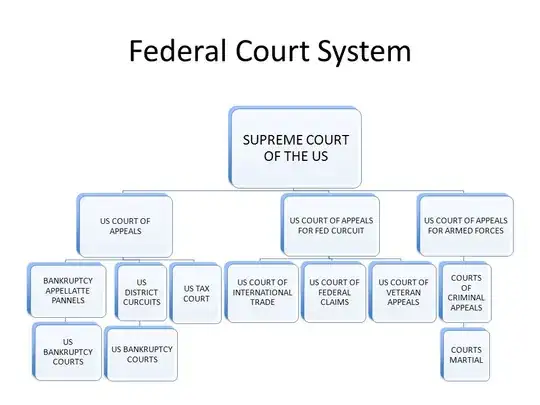
State and Local Court Systems
- 50 state court systems (some more complex and specialized than others, see below), all of which have appeals from the highest state court to the U.S. Supreme Court on questions of federal law (which in one sense makes them all part of one U.S. court system);
- Unemployment tribunals in every state;
- Worker's compensation tribunals in most states;
- Other state administrative law tribunals (including many state occupational licensing violation tribunals, utility regulators, election administration judges and tribunals, civil service discipline tribunals, property valuation tribunals for property tax purposes, state tax courts, state securities regulators, public sector labor dispute tribunals, boundary adjustment and determination tribunals, parole boards, health and safety regulation boards, civil rights law enforcement tribunals, license revocation tribunals, etc.);
- State legislatures (impeachment, ethical sanctions for members, expulsion of members, disputed parliamentary procedure questions).
- University internal student and faculty discipline tribunals;
- State national guard and state defense force military justice proceedings;
"Local" courts created with state authority
- Thousands of independent municipal or local courts that aren't part of a state court system (in some states, there are no such courts and all matters handled by these courts in other states are handled by limited jurisdiction state courts that are part of the state court system);
- Municipal and local government administrative tribunals (e.g. land use regulation boards, civil service system discipline, liquor license revocation tribunals, parking violation courts, etc.), sometimes a city council or school board will directly serve in a quasi-judicial role for this purpose as well;
- Coroner's juries (ad hoc, but potentially one per coroner); and
- Public trustees (who adjudicate non-judicial deed of trust foreclosures in some mostly Western states).
To illustrate the variety of state court systems consider some of the following (which often omits division of theoretically unified courts that in practice operate as separate courts within a system like small claims divisions of limited jurisdiction trial courts):
California and Georgia compared:
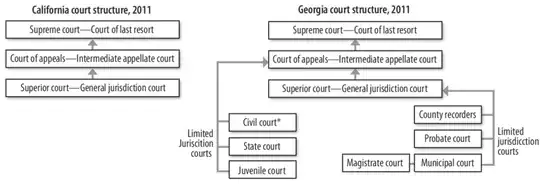
Colorado (including municipal courts that aren't part of the state court system, which appeal to county courts if they are not courts of record in trials de novo and to district court appeals if they are courts of record):

Delaware:
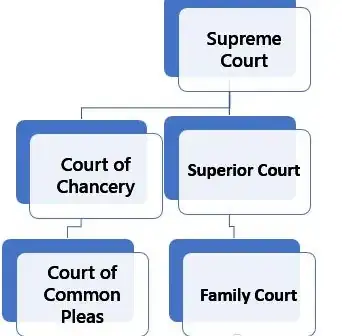
New York:
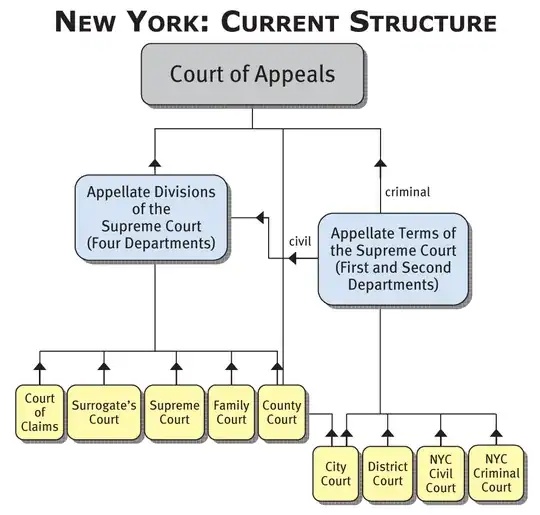
Texas (with one highest court for criminal cases and another for civil cases):
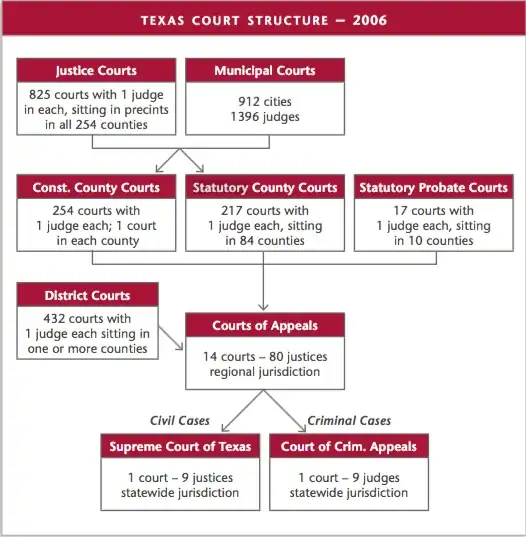
Utah (in which civil appeals go straight from the trial court to the state supreme court unless the state supreme court delegates a civil appeal to the intermediate court of appeals):
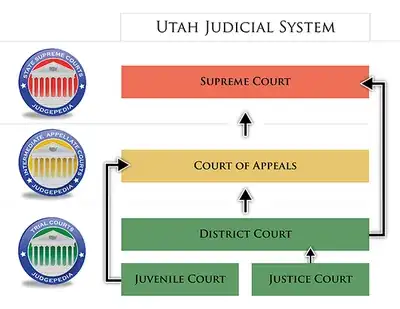
Wyoming (with no intermediate appellate courts):
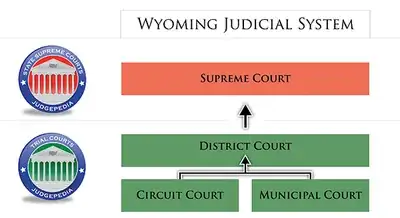
Private or Quasi-Private Sector Legal Systems
Also, there are on the borderline, private and quasi-private dispute resolution tribunals, including among the largest and most notable ones below.
Many of these have almost as much authority as ordinary civilian state and federal courts but apply only to people who have subjected themselves to their jurisdiction voluntarily somehow and are buttressed mostly by the Federal Arbitration Act with a handful of exceptions (e.g., labor arbitration has a separate legal basis).
- Roman Catholic Canon Law courts.
- The American Arbitration Association system.
- The JAG (Judicial Arbiter Group) system.
- The Securities Industry arbitration system.
- The Realtors' organization arbitration system.
- The International Chamber Of Commerce Arbitration system.
- The Jewish family law arbitration system.
- The Olympic Sports arbitration system.
- The Labor-Management arbitration system (partially government sponsored parallel to the NLRB).
- The ICANN Internet domain name administrative panel.
- Dispute resolution committees of major political parties.







